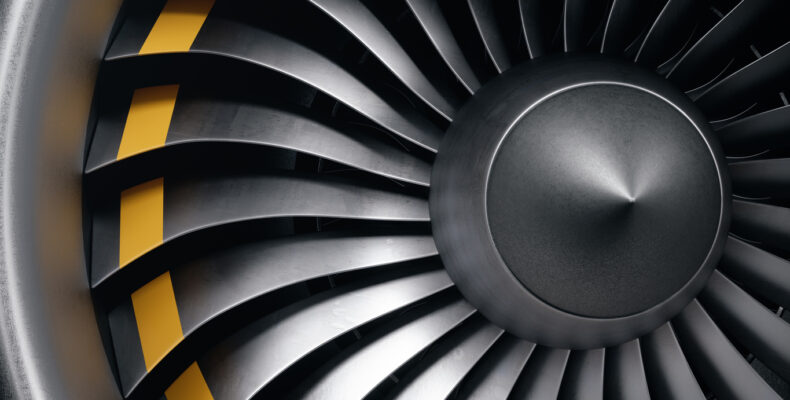
The sky is the limit for aerospace IP
Historically, the aerospace sector has been a major player in the world of Intellectual Property (IP). While technology and consumer electronics groups are often the first that spring to mind as being at the cutting edge, aerospace companies are amongst the world’s largest in terms of research funding. This level of innovation is reflected in the size of these companies’ patent portfolios.
Of the top 300 organisations granted the most US patents in 2022, the aerospace sector is well represented. Boeing and Airbus, which dominate the airliner market, rank at 36th and 82nd respectively; defence giant Raytheon makes it into 9th position; and aircraft systems manufacturers such as General Electric, Honeywell and Rolls Royce all make the top 100.
Growth & opportunity
This level of research and development is to be expected when one considers the tremendous growth that the industry has experienced over the past few decades. Official figures show that from 2010 to 2019, the number of air passengers carried per year grew from 2.63 billion to 4.56 billion – an increase of 93%. And despite the COVID-19 pandemic dramatically reducing airline activity more recently, this growth is expected to continue, with passenger numbers expected to reach 2019 levels again by 2024.
Of course, the increase in demand for air travel is accompanied by substantial commercial opportunity. Airbus’ Global Market Forecast and Boeing’s Commercial Market Outlook are both optimistic about the direction of the industry over the next 20 years. An estimated 40,000 new aircraft are expected to be delivered globally during this period, which will result in the total worldwide aircraft fleet approximately doubling in size. Passenger traffic is expected to grow by 3.7% year-on-year, with the total amount of air cargo also growing by 3.2 to 4.1% year-on-year over the same timeframe.
This growth has been matched by prolific IP activity. According to WIPO’s PATENTSCOPE data, the number of published ‘Aircraft; Aviation; Cosmonautics’ patent applications (International Patent Classification: B64) increased from 12,382 in 2012 to 38,804 in 2021 – more than a threefold increase. These patents also appear to cover a wide range of aviation technologies. While just over half of the patents in the database (238,244 of 470,526 in total) were for ‘Airplanes; Helicopters’ (IPC: B64C), nearly as many (192,904) were applications related to ‘Equipment for fitting to aircraft; Flight suits; Parachutes; Arrangements or mounting of power plants or propulsion transmission in aircraft’ (IPC: B64D).
Chinese market
One notable trend is the growth of aerospace patent applications from China. The same data showed the number of Chinese filings was 30% greater than that of the US, and more than four times that of the EPO. Boeing predicts that intra-China air passenger numbers will surpass intra-North America by 2041 to take the number one spot as the largest passenger flow in the world, having overtaken intra-Europe routes recently and Europe-North America routes in the 2010s.
The growth of the Chinese domestic market, which averaged 11% annually in the period of 2012 to 2019, has evidently spurred an interest in the region. While legacy manufactures will be keen to capitalise on this, the demand has also created new competition. China’s first domestic airliner, the Comac C919, entered into commercial service with China Eastern Airlines at the end of May 2023. Additionally, Comac has already partnered with Russian aircraft manufacturer United Aircraft Corporation to develop a widebody aircraft, with preliminary design work already well underway. Clearly the recent patent filings, predicted passenger numbers, and ongoing commercial developments all indicate that the only way is up for the Chinese aviation market.
Innovative technologies
But this is not the only trend that has been hallmarked by patenting activity. Research by the Aerospace Technology Institute, an industry working group, identified a number of IP trends that signposted growth areas within the industry. As well as noting the growth potential in China, the research identified three technologies of significant patenting interest: Vertical Take-Off and Landing (VTOL) Rotorcraft; Electrical Power Systems; and Advanced Structures and Net-shape Manufacturing.
The increase in the number of patents for these technologies in the mid-2010s has either accompanied or predicted significant interest in the technologies themselves. Currently, EHang is in the process of gaining regulatory compliance for its unpiloted VTOL ‘air-taxi’, with many analysts predicting that such VTOL aircraft could be relatively commonplace for small-scale people transportation and cargo delivery by the end of the decade. Meanwhile, electrical power systems are perhaps the most sought-after technology, as manufacturers and airlines attempt to de-carbonise in the face of approaching climate change deadlines. Similarly, structures and manufacturing techniques continue to be developed, with the current generation of airliners (for example, the Boeing 787 and Airbus A350) using composite materials extensively in their construction.
Overall, Intellectual Property appears to be at the forefront of developments in aerospace. The number of patent filings has continued to grow alongside passenger and aircraft numbers in recent years. Furthermore, patenting strategy seems to be aligned with industry strategy, both in terms of key technology areas and geographic regions of interest. With aviation activity expected to continue expanding in the coming years, particularly as the COVID-19 recovery comes to an end, there is perhaps never a better time to consider what IP can do for the sector.
Barker Brettell has extensive experience working with aerospace technologies, and the expertise required to help you realise the potential of your innovations. If you would like to find out more, please contact the author or your usual Barker Brettell attorney.



